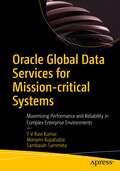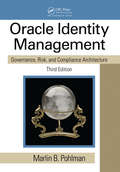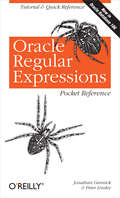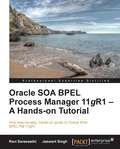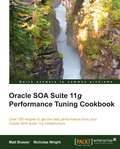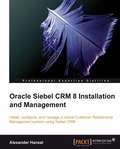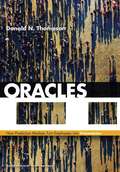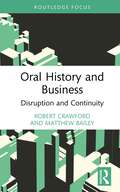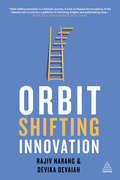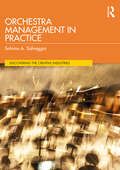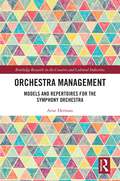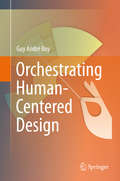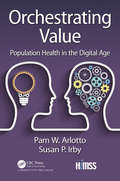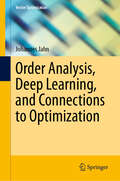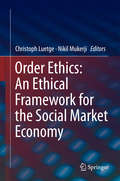- Table View
- List View
Oracle Global Data Services for Mission-critical Systems: Maximizing Performance and Reliability in Complex Enterprise Environments
by Y V Kumar Mariami Kupatadze Sambaiah SammetaNew to Oracle Global Data Services? You’ve come to the right place. This book will show you how to leverage the power of Oracle GDS to ensure runtime load balancing, region affinity, replication lag tolerance-based workload routing, and inter-database service failover. In particular, you will see how to maximize the utilization of replication investments with Oracle GDS. The book starts by guiding you through the installation and configuration of GDS and provides details for each component in the GDS framework. Next, you’ll learn how to configure various components of Oracle GDS in standalone environments. Hands-on exercises that explore the advantages of GDS with different test cases utilizing Active Data Guard (ADG), Oracle GoldenGate (OGG), and Oracle Real Application Clusters (RAC) will help you put your learning in context. The book concludes with a demonstration of how to add Oracle GDS to OEM for monitoring and troubleshooting. You’ll also see how to monitor Oracle GDS in a centralized location using Oracle Enterprise Manager Cloud Control. After completing this book, you will understand the architecture, components, and implementation strategies of GDS using ADG and OGG in mission-critical environments. What You Will Learn Understand Oracle Global Data Services architecture and its various componentsInstall and configure Oracle Global Data ServicesUse Global Data Services with Active Data Guard and Oracle Golden Gate.Monitor Global Data Services using Oracle Enterprise Manager Cloud Control.Troubleshoot issues in Global Data Services Who This Book Is For Oracle database administrators, Oracle database architects, Oracle technical managers, Oracle application business analysts, and Oracle data engineers.
Oracle Identity Management: Governance, Risk, and Compliance Architecture, Third Edition
by Marlin B. PohlmanIn the third edition of this popular reference, identity management specialist Marlin B. Pohlman offers a definitive guide for corporate stewards struggling with the challenge of meeting regulatory compliance. He examines multinational regulations, delves into the nature of governance, risk, and compliance (GRC), and outlines a common taxonomy for the GRC space. He also cites standards that are used, illustrating compliance frameworks such as BSI, ITIL, and COBIT. The text focuses on specific software components of the Oracle Identity Management solution and includes elements of the Oracle compliance architecture.
Oracle Regular Expressions Pocket Reference: Tutorial & Quick Reference
by Jonathan Gennick Peter LinsleySupport for regular expressions in SQL and PL/SQL is one of the most exciting features of Oracle Database 10G. Oracle has long supported the ANSI-standard LIKE predicate for rudimentary pattern matching, but regular expressions take pattern matching to a new level. They provide a powerful way to select data that matches a pattern, as well as to manipulate, rearrange, and change that data.This concise pocket guide is part tutorial and part quick-reference. It's suitable for those who have never used regular expressions before, as well as those who have experience with Perl and other languages supporting regular expressions. The book describes Oracle Database 10G's support for regular expressions, including globalization support and differences between Perl's syntax and the POSIX syntax supported by Oracle 10G. It also provides a comprehensive reference, including examples, to all supported regular expression operators, functions, and error messages.O'Reilly's Pocket References have become a favorite among developers and database administrators everywhere. By providing a wealth of important details in a concise, well-organized format, these handy books deliver just what you need to complete the task at hand. Whether you're using regular expressions for the first time or applying your skills from other languages to the latest version of Oracle, the Oracle Regular Expressions Pocket Reference is the book to have close by.
Oracle SOA BPEL Process Manager 11gR1 – A Hands-on Tutorial
by Jaswant Singh Ravi SaraswathiThis hands-on, example-driven guide is a practical getting started tutorial with plenty of step-by-step instructions for beginner to intermediate level readers working with BPEL PM in Oracle SOA SuiteWritten for SOA developers, administrators, architects, and engineers who want to get started with Oracle BPEL PM 11g. No previous experience with BPEL PM is required, but an understanding of SOA and web services is assumed
Oracle SOA Suite Performance Tuning Cookbook
by Nicholas Wright Matt BrasierThis is a Cookbook with interesting, hands-on recipes, giving detailed descriptions and lots of practical walkthroughs for boosting the performance of your Oracle SOA Suite.This book is for Oracle SOA Suite 11g administrators, developers, and architects who want to understand how they can maximise the performance of their SOA Suite infrastructure. The recipes contain easy to follow step-by-step instructions and include many helpful and practical tips. It is suitable for anyone with basic operating system and application server administration experience.
Oracle Siebel CRM 8 Installation and Management
by Alexander HansalThis book provides a practical, hands-on experience. Chapter by chapter, a Siebel CRM self-study environment is created which can be used to follow the examples described in the book to explore the Siebel functionality. The book ensures that you understand what you are doing and why you are doing it. It contains clear step-by-step instructions, explanatory tables, screenshots, and precise diagrams. This book is for administrators who want to develop and strengthen their Siebel CRM skills in the areas of installation and system management. Whether you are a novice or a more experienced user, this book will teach you something new in many ways and by the end of the book, you will be ready to install and manage Siebel CRM in a real-world environment.
Oracle vs. salesforce.com
by David B. Yoffie Alison Berkley WagonfeldExplores the phenomenon of software becoming a service. Salesforce.com has catapulted into the lead for offering a customer relationship management (CRM) solution as a Web-based service. Siebel, the leader in CRM packaged software sales, has to devise a strategy to compete with salesforce.com
Oracles
by Donald N. ThompsonWhy Prediction Markets Are Good for BusinessFrom selecting the lead actress in a Broadway musical, to predicting a crucial delay in the delivery of Boeing's 787 Dreamliner months before the CEO knew about it, to accurately forecasting US presidential elections-prediction markets have realized some amazing successes by aggregating the wisdom of crowds.Until now, the potential for this unique approach has remained merely an interesting curiosity. But a handful of innovative organizations-GE, Google, Motorola, Microsoft, Eli Lily, even the CIA-has successfully tapped employee insights to change how business gets done.In Oracles, Don Thompson explains how these and other firms use prediction markets to make better decisions, describing what could be the origins of a social revolution. Thompson shows how prediction markets can: draw on the hidden knowledge of every employee tap the "intellectual bandwidth" of retired employees replace surveys substitute for endless meetingsBy showing successes and failures of real organizations, and identifying the common roadblocks they've overcome, Oracles offers a guide to begin testing expertise against the collective wisdom of employees and the market-all to the benefit of their bottom line.
Oracles, Heroes or Villains: Economic Policymakers, National Politicians and the Power to Shape Markets
by George E. ShambaughIMF Managing Director Christine Lagarde declared central bankers and finance ministers to be the heroes of recent economic crises for taking corrective action while national politicians squabbled. What enabled them to do so? In the wake of Brexit, chaotic trade policies in the United States, and resurgent nationalism around the world, national politicians are quarrelling again, meanwhile the markets are roiling. Can we again depend on economic technocrats to save the day for these national politicians and the rest of us? What happens if they fail or, perhaps worse, go too far? In this timely book, Shambaugh answers these questions using recent economic crises in Argentina, the United States and Europe as case studies for analysing the intersections of power, politics and markets. By specifying the interactions between political uncertainty, market intervention, and investor risk, Shambaugh predicts how economic technocrats manage market behaviour by shifting expectations regarding what national politicians will do and whether their policies will be effective.
Oral History and Business: Disruption and Continuity
by Robert Crawford Matthew BaileyThis book introduces business historians to oral history methodologies and approaches. Using four distinct oral history case studies to explore ideas of disruption and continuity in business history over the second half of the twentieth century, Robert Crawford and Matthew Bailey demonstrate how critical engagement with oral history approaches serves to enhance and enliven business history as well as its relationship with other historical fields. The focus on disruption is used to encompass a broad set of processes such as technological change, the impact of external forces, informal business networks, social constructions of gender, knowledge transfer, firm adaptability and cultural change. The use of oral histories to interpret responses to disruption in the past, and to explore the features characterising business continuity, provides an opportunity to consider the human dimensions, subjective experiences and personal insights of workplace, firm and industry change. It also sheds light on the ways that people and firms respond to disruptive forces through innovation and adaptation – both successfully and unsuccessfully. This succinct and accessible account is essential reading for business historians with little experience in using oral history, as well as those looking to gain deeper insights from their oral history data.
Orange: Read&Go
by Elena Corsi Vincent Dessain Thomas R. Eisenmann Toby Stuart Bhaskar Chakravorti Simon HarrowIn late 2008, Orange (aka France Telecom) must decide if launching Read&Go, an electronic newsstand built around an e-paper reader, would be successful. The case describes: 1) Orange's strategy; 2) the company's new product development process; 3) e-paper technology, which simulates the appearance of printed paper on a screen; 4) consumer demand for e-paper services; 5) potential competitors, including Amazon's Kindle; 6) business model options for Orange's service; and 7) the reactions of French newspapers - crucial content partners - to Orange's proposal.
Orbit-Shifting Innovation
by Rajiv Narang Devika DevaiahOrbit-shifting innovation happens when an area that needs transformation meets an innovator with the will and the desire to create, and not follow, history. At the heart of every orbit-shifting innovation is the breakthrough that achieves a transformative impact.Businesses, social enterprises and even governments need orbit-shifting ideas to create a transformative impact. But how does that ground breaking idea come about, and what translates it into actuality? Charting the vast global landscape of orbit-shifting innovation and using unique examples from prominent businesses, the social sector, entrepreneurs and public services - spread across US, UK, Europe, Africa and Asia - the authors build insight into the key drivers behind taking on a transformative challenge and provide a unique framework to navigate the pitfalls and challenges in making it happen. Orbit-shifting innovation empowers everyone to overcome the obstacles to innovation and provides the tools to maximize the impact of transformative change. The inspirational examples and tools for success compel leaders and entrepreneurs to not only pursue impossible challenges but lead the successful journey from conception of an orbit-shifting idea to actually creating history.
Orchadio's First Two Split Experiments
by David Lane Marco Iansiti Iavor BojinovOrchadio, a direct-to-consumer grocery business, needs to conduct its first two A/B tests-one to evaluate the effectiveness and functioning of its newly redesigned website, and one to market-test four versions of a new banner for the website. To do so, it will rely on a technology management platform designed by Split Software, whose feature flags allow Orchadio engineers to (1) turn specific software features on and off and (2) to limit access to those features to specific groups of website visitors. These capabilities in turn enable A/B feature testing. Split also offers data analytics to allow Orchadio to assess how its tests affect a plethora of Orchadio's business, software, and operating metrics. Orchadio managers now need to decide how to design their experiments for maximum impact, including whether or how to sequence them.
Orchestra Management in Practice (Discovering the Creative Industries)
by Salvino A. SalvaggioIntroducing the business models, organisational structures, and fundamentals of orchestras, this book takes readers on a journey through the evolution of orchestra management. The author explores the dynamics between artistic excellence and financial sustainability. Key aspects of orchestra management are examined in detail, including artistic programming, strategic planning, financial and compliance/legal matters, audience development, resilience and adaptability, governance and board relations, diversity and inclusion, partnerships, and the role of technology and innovation. With actionable resources, such as checklists, templates, and frameworks, for current and future orchestra leaders and managers, this comprehensive guide empowers readers in education and practice to navigate the complexities of orchestra management confidently and effectively.
Orchestra Management: Models and Repertoires for the Symphony Orchestra (Routledge Research in the Creative and Cultural Industries)
by Arne HermanEvery orchestra in the world oscillates between crisis and survival. This perpetual movement makes innovation, both in organizational form and in artistic product, vital to the sustainability of the symphony orchestra. Based on case study research in Flanders, Amsterdam and London, this book reflects on the sustainability crisis of the orchestra by framing it as a legitimacy crisis that affects both the orchestra’s artistic and organizational identity. The aim of this book is to explore the dynamics between various and often conflicting factors in the orchestra’s quest for survival, and to show how these organizational dynamics relate to the orchestra’s repertoire. By highlighting the importance of every organization’s specific environment to which it needs to adapt, this book illustrates that the orchestra field is not a field that relies on best practices. The book reflects on conventional as well as innovative orchestra models, making the comparative point of view relevant for academic or practice-based researchers, orchestra managers, policymakers and subsidizing bodies interested in sustainable and future-oriented orchestra management.
Orchestrate Conflict: Leading Adaptive Change by Surfacing and Managing Conflict
by Alexander Grashow Marty Linsky Ronald HeifetzEveryone has a different capacity for tolerating conflict. Some people are comfortable working through conflict, while most avoid it entirely. But surfacing the relevant conflicts is essential if you want to generate progress on adaptive issues. To do this well requires an approach to conflict that teases out the unacknowledged differences in perspectives on the issues that may be preventing the organization from reaching its goals. It requires acknowledging the many competing visions, values, and views that may be present in the organization even if they are not articulated. Orchestrating conflict isn't easy, but this chapter provides seven steps to follow, along with practices that will help you surmount the difficulties of orchestrating conflict and boost your chances of success. This chapter was originally published as chapter 11 of "The Practice of Adaptive Leadership: Tools and Tactics for Changing Your Organization and the World."
Orchestrate the Conflict (How to Creatively Engage Conflict to Achieve Leadership Goals)
by Marty Linsky Ronald A. HeifetzThis chapter notes that addressing tough issues involves managing conflict. Most people's default mind-set is to limit or deflect conflict. But the challenge of leadership when trying to generate adaptive change is to work with differences, passions, and conflicts in a way that diminishes their destructive potential and constructively harnesses their energy. This chapter was originally published as Chapter 5 of "Leadership on the Line."
Orchestrating Adjacency Moves: Strengthening the Core Versus Investing in Adjacencies
by Chris ZookEven the most attractive growth opportunity can turn unattractive, unrealistic, or even destructive when bolted onto the wrong core business, or onto the right business at the wrong time. Building growth on a core business that is prepared to support it, and for which the new adjacency moves might even reinforce the strength of that core rather than draining it of its energy, is crucial. This chapter examines the issue of timing and assessing the state of the core to support growth.
Orchestrating Human-Centered Design
by Guy BoyThe time has come to move into a more humanistic approach of technology and to understand where our world is moving to in the early twenty-first century. The design and development of our future products needs to be orchestrated, whether they be conceptual, technical or organizational. Orchestrating Human-Centered Design presents an Orchestra model that attempts to articulate technology, organizations and people. Human-centered design (HCD) should not be limited to local/short-term/linear engineering, but actively focus on global/long-term/non-linear design, and constantly identify emergent properties from the use of artifacts. Orchestrating Human-Centered Design results from incremental syntheses of courses the author has given at the Florida Institute of Technology in the HCD PhD program. It is focused on technological and philosophical concepts that high-level managers, technicians and all those interested in the design of artifacts should consider. Our growing software -intensive world imposes better knowledge on cognitive engineering, life-critical systems, complexity analysis, organizational design and management, modeling and simulation, and advanced interaction media, and this well-constructed and informative book provides a road map for this.
Orchestrating Value: Population Health in the Digital Age (HIMSS Book Series)
by Susan Irby Pam ArlottoOrchestrating Value: Population Health in the Digital Age focuses on the leadership thinking and mindset changes needed to transition from brick and mortar healthcare to digital health and connected care. The fourth industrial revolution, with convergent disruptions in biology, business models, computer science, and culture, has the potential to transform the healthcare system like never before. Digital health startups, Big Tech and progressive health systems will change the way health and healthcare are delivered to increasingly digitally savvy consumers. This book challenges readers to rethink the role of data and technology in creating and designing the future. Rather than hooking value-based care and population health management onto traditional healthcare business models, it focuses on the emergence of digital ecosystems. Using the analogy of an orchestra, the book introduces the importance of platforms in the formation of communities and markets with network effects to allow participants to collaborate, create, and innovate. With quotes from healthcare industry leaders and change agents, it helps the strategist understand the three stages of the transition from volume to value. As conductor of the orchestra, the CEO must navigate important leadership pivots to move beyond silo-based thinking. Finally, the Care Management Platform is described as a new operating model for population health in the digital age. As the next generation beyond foundational EHRs, capabilities such as interoperability, analytics, care management and patient/consumer engagement will fundamentally change the way healthcare enterprises operate and deliver value to customers.
Orchestrator: Choosing the Optimal Business Model for Innovation
by John Butman Harold L. Sirkin James P. AndrewThe choice of business model can have a dramatic effect on a company's ability to successfully achieve payback with a new product or service. This chapter examines the popular model of innovation collaboration or orchestration, in which risk and payback are shared among partners.
Orchid Partners: A Venture Capital Start-Up
by Myra M. Hart Kristin J. LiebThe development of a new venture partnership and the challenges associated with raising its first fund are chronicled. The decision to focus on early-stage investments, the determination of the appropriate size of the fund, the fund-raising process, and the steps in closing are all examined. Also presents information on the relationships among the five partners, the division of responsibilities, and the compensation package. Provides personal background on each of the partners and explores their motivation for choosing this career change at this particular moment in their lives.
Orchid Partners: A Venture Capital Start-Up
by Myra M. Hart Kristin J. LiebThe development of a new venture partnership and the challenges associated with raising its first fund are chronicled. The decision to focus on early-stage investments, the determination of the appropriate size of the fund, the fund-raising process, and the steps in closing are all examined. Also presents information on the relationships among the five partners, the division of responsibilities, and the compensation package. Provides personal background on each of the partners and explores their motivation for choosing this career change at this particular moment in their lives.
Order Analysis, Deep Learning, and Connections to Optimization (Vector Optimization)
by Johannes JahnThis book introduces readers to order analysis and various aspects of deep learning, and describes important connections to optimization, such as nonlinear optimization as well as vector and set optimization. Besides a review of the essentials, this book consists of two main parts. The first main part focuses on the introduction of order analysis as an application-driven theory, which allows to treat order structures with an analytical approach. Applications of order analysis to nonlinear optimization, as well as vector and set optimization with fixed and variable order structures, are discussed in detail. This means there are close ties to finance, operations research, and multicriteria decision making. Deep learning is the subject of the second main part of this book. In addition to the usual basics, the focus is on gradient methods, which are investigated in the context of complex models with a large number of parameters. And a new fast variant of a gradient method is presented in this part. Finally, the deep learning approach is extended to data sets given by set-valued data. Although this set-valued approach is more computationally intensive, it has the advantage of producing more robust predictions. This book is primarily intended for researchers in the fields of optimization, order theory, or artificial intelligence (AI), but it will also benefit graduate students with a general interest in these fields. The book assumes that readers have a basic understanding of functional analysis or at least basic analysis. By unifying and streamlining existing approaches, this work will also appeal to professionals seeking a comprehensive and straightforward perspective on AI or order theory approaches.
Order Ethics: An Ethical Framework for the Social Market Economy
by Christoph Luetge Nikil MukerjiThis book examines the theoretical foundations of order ethics and discusses business ethics problems from an order ethics perspective. Order ethics focuses on the social order and the institutional environment in which individuals interact. It is a well-established paradigm in European business ethics. The book contains articles written by leading experts in the field and provides both a concise introduction to order ethics and short summary articles homing in on specific aspects of the order-ethical paradigm. It presents contributions describing fundamental concepts, historical roots, and the economic, social, and philosophical background of the theory. The second part of the handbook focuses on the theory's application in business, society, and politics, casting new light on an array of topics that loom large in contemporary ethical discourse.
